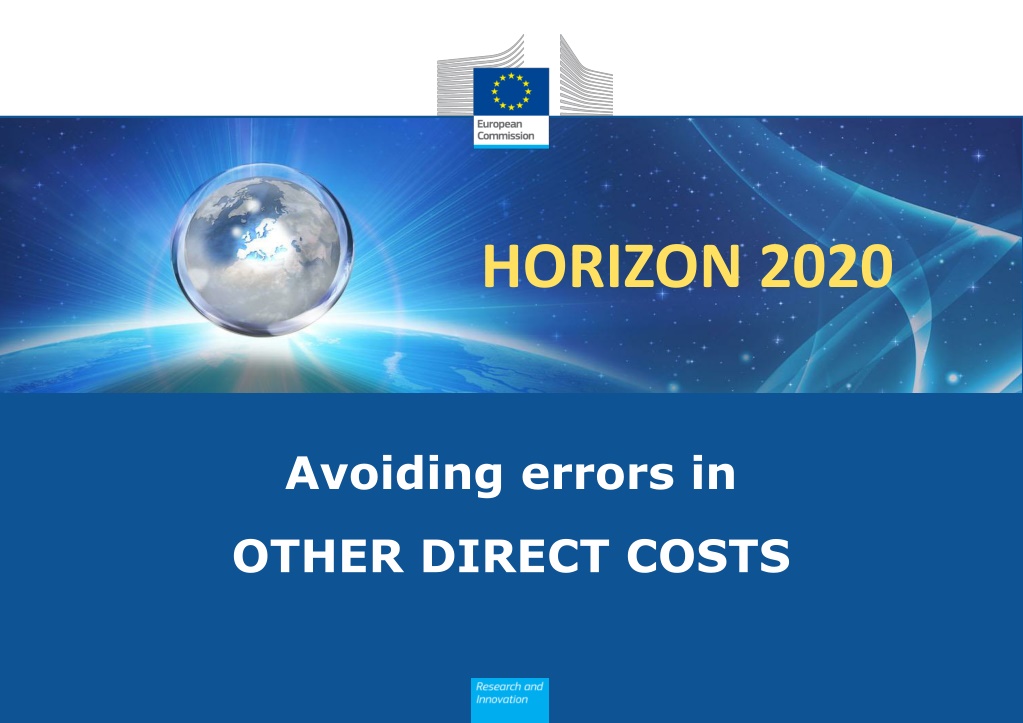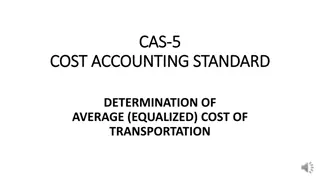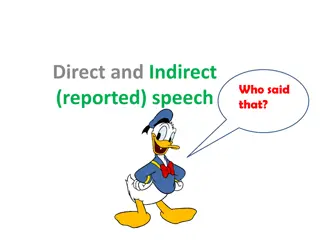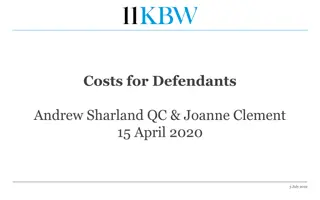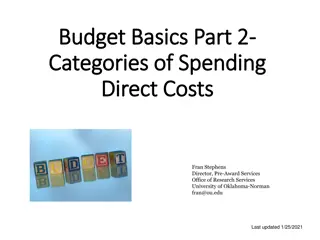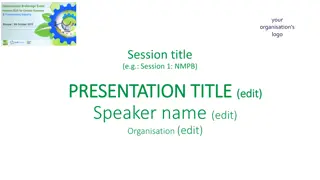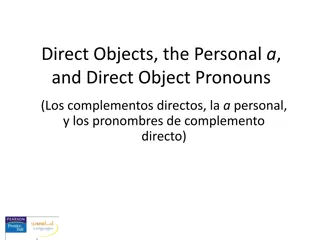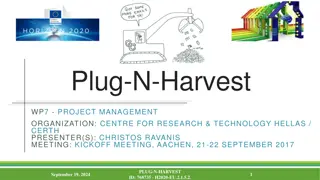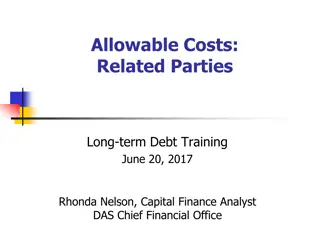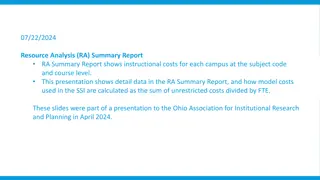Guidelines for Direct Costs in H2020 Funding
Direct costs in Horizon 2020 funding must be accurately measured and attributed only to the specific action being funded. Costs must be directly linked to the implementation of the action and supported with sufficient evidence. It is crucial to avoid errors in other direct costs, ensure proper recording for auditability, and follow guidelines for charging different types of expenses to the funded action, such as energy supply, administrative staff, and equipment depreciation. Additionally, understanding the differences between contracts and subcontracts is essential to ensure best value for money and compliance with regulations.
Download Presentation

Please find below an Image/Link to download the presentation.
The content on the website is provided AS IS for your information and personal use only. It may not be sold, licensed, or shared on other websites without obtaining consent from the author.If you encounter any issues during the download, it is possible that the publisher has removed the file from their server.
You are allowed to download the files provided on this website for personal or commercial use, subject to the condition that they are used lawfully. All files are the property of their respective owners.
The content on the website is provided AS IS for your information and personal use only. It may not be sold, licensed, or shared on other websites without obtaining consent from the author.
E N D
Presentation Transcript
HORIZON 2020 HORIZON 2020 Avoiding errors in OTHER DIRECT COSTS
The Framework Programmes timeline 2007 2014 2021 Cost reimbursement Each Programme has its own rules ! Lump sum grants Horizon Europe Unit costs grants (MSCA)
Direct costs for the action Direct costs are costs that are directly linked to the action's implementation and can be attributed to it directly. They must not include any indirect costs. Identification of Direct Costs: Direct costs are: Measurement costs that have been caused in full by the action or costs that have been caused in full by several actions and the attribution to a single action can, and has been, directly measured (e.g. not allocated via cost drivers)
Direct costs for the action Must be justified by sufficient persuasive evidence showing the direct link to the action Must be properly recorded in order to allow direct measurement of the use for the action and to ensure auditability The measurement system used by the beneficiary must accurately quantify the cost Direct measurement of costs does not mean fair apportionment of costs through proxies, cost drivers or allocation keys. Once you use them, it's indirect cost!
Auditor's advice: direct measurement Energy and power supply: can I charge it as direct in H2020? Yes, if you can measure it Administrative staff members doing accounting for the action: can I charge them to the action? Yes, but with time sheets and only ifit is your usual practice Multi-purpose equipment used for several activities/actions: can I charge its depreciation to an EU action as a % of its capacity based on my experience? No. You have to measure its use.
Contracts vs Subcontracts For the purchase of goods, works or services Contracts Ensure best value for money and avoid any conflict of interests Beneficiary E.g.: CFS, supply of consumables, etc. Estimated costs and tasks must be identified in the budget and in Annex 1 If not identified in Annex 1, Commission may still approve them (beneficiary bears the risk of rejection) Subcontracts Ensure best value for money and avoid conflict of interests ! Subcontracting between beneficiaries is not allowed. Subcontracting to affiliates is generally not allowed either Disclaimer: Information not legally binding
Subcontracts vs. Contracts Disclaimer: Information not legally binding
Best Practice You must demonstrate 'best value for money', both in sub-contracting and in purchases of goods and services Some level of tendering to demonstrate 'best value' e.g. tender, three offers, market survey, etc. Naming the supplier in the grant does not mean that you do not have to demonstrate best value We will normally accept your standard practices, when properly used Your accounting practices are not panacea! (e.g. cash basis depreciation is not automatically accepted even if it is in line with your accounting practices) ! Disclaimer: Information not legally binding
Auditor's advice: Best value for money I have named my subcontractor in the Annexes to the GA is it enough? No, because you are still deemed to have respected the best value for money My subcontractor is a friend is it a problem? As such not. But you must be in a position to prove that his/her offer represents the best price-quality ratio The conflict of interests rule requires you to adopt every measure to avoid it (including family and emotional ties) I use the same IT provider since 20 years, with a written framework contract is it OK? If you use it for you and for us, then OK. However, maybe it is time to look for better prices Disclaimer: Information not legally binding
Conflict of interests Avoid conflict of interests (Art.35 of the MGA) 'The beneficiaries must take all measures to prevent any situation where the impartial and objective implementation of the action is compromised for reasons involving economic interest, political or national affinity, family or emotional ties or any other shared interest ( conflict of interests ).' Disclaimer: Information not legally binding
Conflict of interests Avoid conflict of interests (Art.35 of the MGA) The beneficiaries must formally notify the EC/Agency without delay any situation constituting or likely to lead to a conflict of interests and immediately take all the necessary steps to rectify this situation. Non-compliance may have consequences (reduction of grant, termination). Disclaimer: Information not legally binding
Auditor's advice: Establishing systems from the start You must demonstrate 'best value for money' and take measures to avoid 'conflict of interests' in Sub-contracting and in Purchase of Goods, Works, Services (including durable equipment) Recurrent errors 'Best value' not demonstrated no tender, no counter- offers, no market survey Participants' own normal practices not applied No documentation kept Conflict of interests overriding any competition Disclaimer: Information not legally binding
Equipment Depreciation costs Equipment purchased in accordance with Article 10.1.1 (best value for money, no conflict of interest ); Only the depreciation incurred during the period of the action is eligible, not the full cost, but there are exceptions; Depreciation calculated in accordance with international accounting standards and the beneficiary s usual accounting practices; Useful life action period. Disclaimer: Information not legally binding
Depreciation Examples (1) A beneficiary uses an X-ray machine for the action for few hours and for the rest of the time the X-ray machine is used for other activities. The beneficiary charges the full depreciation costs for the period in the cost statement of the action. NOT ALLOWED! Disclaimer: Information not legally binding
Depreciation Examples (1) The rule If the beneficiary does not use the equipment exclusively for the action, only the portion used on the action may be charged. The amount of use must be auditable. In practice The allocation of the part of the annual depreciation to the H2020 action must be calculated based on the number of hours/days/months of actual use of equipment for the action. The actual use should be directly measured (logbook, etc.) Disclaimer: Information not legally binding
Depreciation Examples (2) A beneficiary applies two different definitions of useful life: Equipment funded by research grants - Term of grant; Other Equipment - 5 years (example). NOT ALLOWED! The useful life of an asset should be determined according to the usual accounting practices and International Accounting Standards. The Beneficiary cannot change its practice on an ad hoc basis to discriminate EU-funded and non-EU funded assets. Disclaimer: Information not legally binding
CFS A reminder Legal basis Art 20.4(b)(ii) H2020 GA. Threshold: 325,000 Declared actual costs + unit costs calculated on the basis of usual cost accounting practices (average personnel costs & internal invoices). 1 certificate per beneficiary at the end of the action - must be submitted by the coordinator 60 days after end of the last reporting period. Certificate may cover the whole action or each reporting period separately. Costs category "Costs for goods or services . for CFS eligible under Disclaimer: Information not legally binding
Exchange rates provisions Beneficiary's accounts in Euro For purchases in other currencies to its usual accounting practice conversion into Euro according Beneficiary's accounts in other currencies Average of the daily exchange rates published in the Official Journal of the EU calculated over the reporting period Calculation shortcut: youmay use the editable charts on the website of the European Central Bank at: http://www.ecb.europa.eu/stats/exchange/eurofxref/html/index.en.html Disclaimer: Information not legally binding
Whose direct costs? Third parties What is a third party? A legal entity which carries out work of the action, supplies goods or provide services for the action, but which did not sign the grant agreement What types of third parties? THIRD PARTIES 1. Third parties directly carrying out part of the work described in Annex 1 2. Other third parties: providing resources, goods or services to the beneficiaries for them to carry out the work described in Annex 1 3. Third parties receiving financial support (money) from the beneficiary as part of the action. Only when authorised in the call Disclaimer: Information not legally binding
1. Third parties carrying out work in the action Linked third parties Beneficiary Affiliated entities Third parties with a legal link Affiliated entity Subcontractors Under the same direct or indirect control as the beneficiary Under the direct or indirect control of the beneficiary Directly or indirectly controlling the beneficiary 'control' = >50 % shares or majority voting rights or decision-making powers Disclaimer: Information not legally binding
1. Third parties carrying out work in the action Must be identified in the GA (article 14) Linked third parties Same cost eligibility criteria than for beneficiaries Beneficiary Affiliated entities Must submit their own financial statements Third parties with a legal link COM or Agency may request them to accept joint and several liability for their EU contribution ! Affiliated entity Legal link Subcontractors Under the same direct or indirect control as the beneficiary Agreement. Under the direct or indirect control of the beneficiary A legally established relationship not specifically created for the Grant Directly or indirectly controlling the beneficiary It may be in the framework of a legal structure (e.g. the relationship between an association and its members) or through an agreement or contract (not limited to the action). 'control' = >50 % shares or majority voting rights or decision-making powers Disclaimer: Information not legally binding
2. Other third parties Beneficiary Contracts necessary for the implementation Free of charge or against payment ! Only the actual eligible costs of the third party may be charged Must be set out in Annex 1 If not identified in Annex 1, Commission may still approve them (beneficiary bears the risk of rejection) In-kind contributions E.g.: seconded staff, use of equipment Disclaimer: Information not legally binding
Third parties: summary CHARACTERISTICS Types of third parties Provides resources or services Must be indicated in Annex 1 Does work of the action What is eligible? Indirect costs Selecting the third party Articles Linked third party Must be affiliated or have a legal link YES NO Costs YES YES Article 14 Best value for money, avoid conflict of interest Subcontractors YES NO Price YES NO Article 13 International partners No EU funding No EU funding Partner to one beneficiary YES NO YES Article 14a In-kind Must not be used to circumvent the rules Articles 11 and 12 contributions by third parties NO YES Costs YES YES Best value for money, avoid conflict of interest Contractors NO YES Price NO YES Article 10 Only if allowed in the call The beneficiaries activity consists in providing financial support to the target population Financial support to third parties According to the conditions in Annex 1 YES NO Article 15 Disclaimer: Information not legally binding
Third parties: Warnings! Linked third party Third party providing in- kind contributions Goods Services Works Beneficiary Subcontractor The beneficiary retains the sole responsibility for the work and the costs declared! ! If something goes wrong with the third party, the beneficiary will be responsible The beneficiary must ensure that Commission, OLAF and European Court of Auditors can audit its third parties including subcontractors and providers ! In case of an audit to a 3rd party, the beneficiary is also in copy of all relevant communications (announcement of the audit, audit report, etc.) Disclaimer: Information not legally binding
ADDITIONAL INFO: I want to read Horizon 2020 Annotated Grant Agreement http://ec.europa.eu/research/participants/data/ref/h2020/grants_manual/amga/h2020-amga_en.pdf Horizon 2020 On-line Manual https://ec.europa.eu/research/participants/docs/h2020-funding-guide/index_en.htm I read, but it is still not clear National Contact Points https://ec.europa.eu/info/funding- tenders/opportunities/portal/screen/support/ncp Research Enquiry Service http://ec.europa.eu/research/enquiries
HORIZON 2020 Thank you for your attention!
